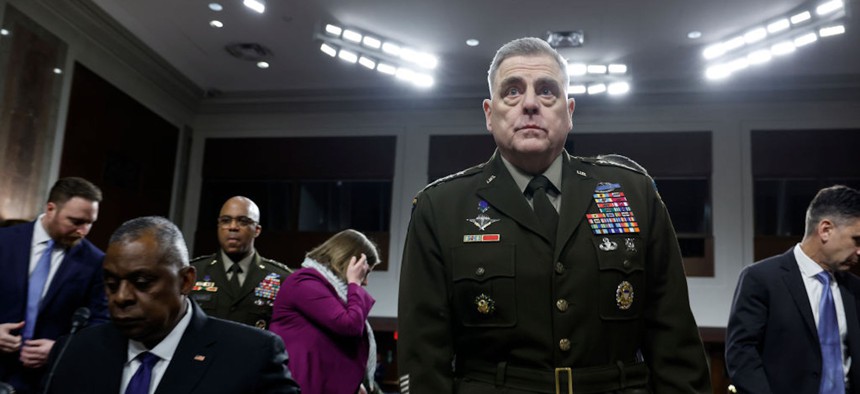
U.S. Secretary of Defense Lloyd Austin (L) and Chairman of the Joint Chiefs of Staff General Mark Milley (R) arrive to a hearing with the Senate Armed Services Committee on Capitol Hill on March 28, 2023 in Washington, DC. hoto by Anna Moneymaker/Getty Images
‘No Magic Weapons’: Milley Sets Expectations On F-16s
Joint Chiefs Chairman defends United States’ gradual approach on weapons for Ukraine.
After months of urging from Ukraine supporters, Norway, Belgium, Portugal, Poland and the Netherlands will soon help train Ukrainian pilots on F-16s—which have been called a possible gamechanger for the war. But Chairman of the Joint Chiefs Gen. Mark Milley on Thursday urged observers to be prepared for the fight to continue on indefinitely.
“There are no magic weapons. An F-16 is not, and neither as anything else,” Milley told reporters at the Pentagon. “Ukraine deserves a capable air force. It's going to take a considerable length of time to build up an air force that's the size and scope and scale that'll be necessary.”
In the meantime, “there's a couple hundred thousand Russian troops in Russian-occupied Ukraine,” he said. Expelling them “might be achievable militarily, but probably not in the near term. So what does that mean? That means fighting is going to continue. It's gonna be bloody. It's gonna be hard.”
Would the fighting ahead be easier had Ukraine gotten F-16s earlier?earlier? Milley said no, adding that the conditions weren’t right in the early stages of the conflict to push advanced aircraft into the mix, not when the Ukrainians had to retake land territory by force. But Milley added some insight into the Pentagon’s thinking on the issue.
“What's the problem to be solved? The problem to be solved, it's controlled airspace…The fastest, quickest, and cheapest way to control that airspace was from the ground. You can either do it from the air or from the ground, and providing effective integrated air defense systems at the low-altitude, short-range altitude, mid-range, and high-altitude long range, that is the most effective way to deny air superiority to the Russians. And that's exactly what they did,” he said.
While new F-16s—likely coming from partners like Poland, not the United States directly, at least not at first—have featured prominently in Capitol Hill hearings on what else Ukraine might need, Milley said Wednesday that the numbers don’t necessarily add up to a big advantage.
“Ten F-16s is a billion dollars. You add the sustainment costs [and it’s] another billion dollars. So you're talking about $2 billion for ten aircraft. The Russians have 1,000 fourth- and fifth-generation fighters.”
A big F-16 package earlier in the war would have resulted in less ground capability for Ukraine, he said, and those capabilities were essential for Ukraine to re-taking territory. “You wouldn't have tanks, you wouldn't have Bradley [fighting vehicles], you wouldn't have anti-armor weapons, you wouldn't have anything else. You'd spend all your money on just that. So it's a cost-risk-benefit analysis that leads you to these separate incremental sort of packages that go forward.”





